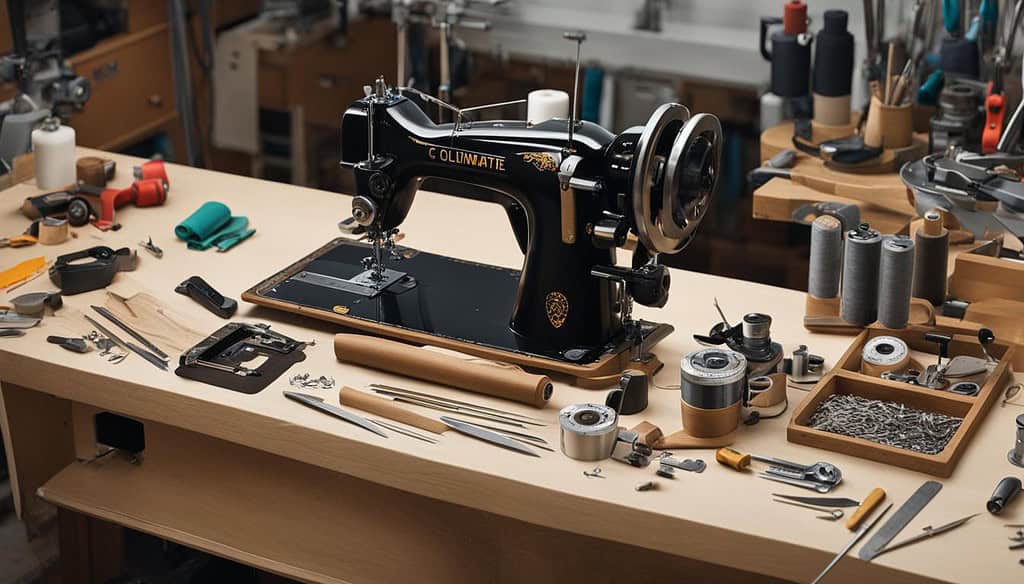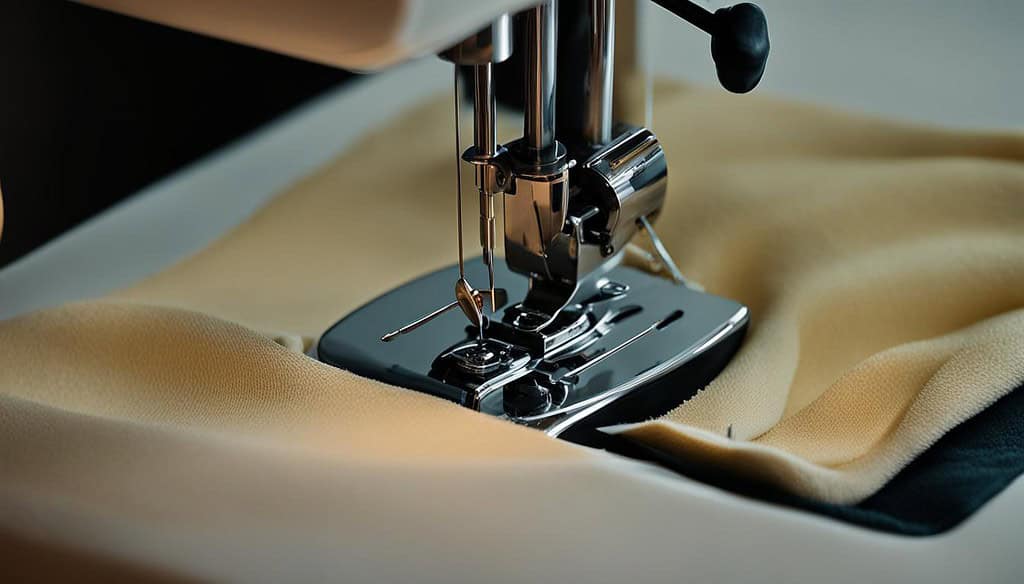Have you ever found yourself in the middle of a sewing project, only to have your trusty sewing machine suddenly stop working? It’s a frustrating experience that can leave you wondering what to do next.
Sewing machine problems, such as thread bunching, broken needles, improper fabric feeding, thread breakage, and skipped stitches, are common issues that can interrupt sewing projects. Regular maintenance, proper machine setup, and using appropriate materials for each project can help minimize these problems and keep sewing enthusiasts stitching smoothly.
In this comprehensive guide, we’ll explore common issues, troubleshooting techniques, and preventive maintenance tips that will keep your machine running like new.
Common Sewing Machine Issues
Sewing machines are complex devices that require regular maintenance and care to function properly. Even with the best upkeep, you may encounter various issues that can disrupt your sewing projects. Let’s explore some of the most common sewing machine problems and how to address them.
Thread Bunching or Breaking
Thread bunching, also known as “bird nesting,” occurs when the thread becomes tangled or knotted under the fabric. This issue can be caused by incorrect threading, improper tension settings, or using the wrong type of thread for your project.
To fix thread bunching, start by completely unthreading and rethreading your machine, ensuring that the thread is correctly seated in the tension discs and the bobbin is properly inserted. Check your sewing machine’s manual for the recommended threading path. Adjust the tension settings according to your fabric type and thickness, as overly tight tension can cause the thread to break.
Using high-quality thread suitable for your project can also help prevent thread breakage. Refer to the table below for a quick guide on choosing the right thread for different fabrics:
| Fabric Type | Recommended Thread |
|---|---|
| Lightweight (e.g., silk, chiffon) | Fine, smooth thread (e.g., 60wt cotton, 100wt silk) |
| Medium-weight (e.g., cotton, linen) | All-purpose thread (e.g., 50wt cotton, polyester) |
| Heavy-weight (e.g., denim, canvas) | Strong, thick thread (e.g., 40wt cotton, heavy-duty polyester) |
Skipped Stitches
Skipped stitches can make your seams look uneven and unprofessional. This problem often arises when using a dull, bent, or incorrectly sized needle. Always choose the appropriate needle size and type for your fabric to ensure proper stitch formation.
Incorrect threading or improper tension settings can also contribute to skipped stitches. Double-check that your machine is threaded correctly and that the tension is balanced. If you’re working with stretchy or slippery fabrics, consider using a walking foot or a roller foot to help feed the material evenly under the needle.
Regularly replacing your needles can help prevent skipped stitches and improve your sewing machine’s performance. As a general rule, change your needle after every 8 hours of sewing or when switching to a different fabric type.
Needle Breaking
Needle breakage is a common and frustrating issue that can happen due to several reasons. One of the main causes is using the wrong needle size or type for your fabric. Always consult your sewing machine’s manual or a needle chart to choose the appropriate needle for your project.
Sewing over pins, thick seams, or heavy embellishments can also cause needles to break. To avoid this, remove pins as you sew and use a hump jumper or a jean-a-ma-jig when sewing over bulky areas. Adjust the presser foot pressure if necessary to accommodate thicker fabrics.
Improper insertion of the needle can also lead to breakage. Make sure the needle is fully inserted into the needle clamp and that the flat side of the shank is facing the correct direction (usually toward the back of the machine). Tighten the needle clamp screw securely to prevent the needle from coming loose during sewing.
Fabric Not Feeding Properly
Fabric feeding issues can be incredibly frustrating, resulting in uneven stitches or difficulty sewing altogether. This problem often occurs when the feed dogs, the small metal teeth that move the fabric through the machine, become clogged with lint or debris. Regularly cleaning your sewing machine, especially the feed dog area, can help prevent this issue.
Incorrect presser foot pressure can also cause fabric feeding problems. If the pressure is too low, the fabric may slip or not move through the machine smoothly. On the other hand, if the pressure is too high, the fabric may stretch or pucker. Adjust the presser foot pressure according to your fabric type and thickness, referring to your sewing machine’s manual for guidance.
Using the wrong type of presser foot for your project can also lead to fabric feeding issues. For example, a standard presser foot may not effectively grip slippery or delicate fabrics, causing them to shift or pucker as you sew. Use specialized presser feet, such as a walking foot or a Teflon foot, when working with challenging materials to ensure proper fabric feeding.
To help you troubleshoot fabric feeding issues, consult the following table:
| Problem | Possible Cause | Solution |
|---|---|---|
| Fabric not moving | Feed dogs clogged | Clean feed dogs |
| Fabric slipping | Presser foot pressure too low | Increase presser foot pressure |
| Fabric puckering | Presser foot pressure too high | Decrease presser foot pressure |
| Uneven feeding | Wrong presser foot | Use appropriate presser foot for fabric type |
By understanding these common sewing machine issues and how to address them, you can minimize frustration and keep your sewing projects running smoothly. Regular maintenance, proper use of your machine, and choosing the right tools and settings for your fabric will go a long way in preventing these problems from occurring.
Remember, if you encounter an issue that you cannot resolve on your own, don’t hesitate to consult your sewing machine’s manual or seek assistance from a professional. With patience and practice, you’ll become more adept at troubleshooting and maintaining your sewing machine, allowing you to focus on creating beautiful, well-crafted projects.
How to Repair Sewing Machine: Step-by-Step Approach
In this section, we will guide you through a step-by-step approach to repairing your sewing machine. By following these instructions, you will be able to troubleshoot common issues, examine and test different components, and make the necessary adjustments or replacements to get your sewing machine back in working condition.
Repairing a sewing machine can be a daunting task, but with the right guidance and a systematic approach, it can be a rewarding experience. Whether you are dealing with a broken needle, tangled threads, or issues with the fabric feed, understanding the repair process is essential. Remember, patience and attention to detail are key.
To begin, make sure you have the necessary tools and supplies. This may include a screwdriver, tweezers, cleaning brush, and replacement parts if needed. Having these items on hand will enable you to tackle the repair process effectively.
Next, identify the specific issue with your sewing machine. Is the machine not stitching properly, or is there an unusual noise? Once you have determined the problem, consult your machine’s manual for guidance. This valuable resource will provide insights into troubleshooting and repairing specific issues related to your machine’s make and model.
Now, let’s dive into the step-by-step repair process:
- Begin by disconnecting the sewing machine from the power source to ensure your safety.
- Thoroughly clean and remove any lint or debris from the machine. Use a cleaning brush or tweezers to reach difficult areas.
- Inspect the needle and replace it if necessary. A dull or bent needle can cause stitching problems.
- Check the tension settings and adjust them as needed. Incorrect tension can result in uneven stitches.
- Examine the bobbin and bobbin case for any obstructions or damage. Clean or replace these parts if necessary.
- Inspect the feed dogs and ensure they are moving smoothly. Lubricate them if needed.
- If the motor is running but the machine isn’t stitching, examine the drive belt. Replace it if it appears worn or damaged.
- Test the machine by sewing on a scrap piece of fabric. Make any additional adjustments as needed.
- Once you have completed the repair process, clean and oil the machine according to the manufacturer’s instructions.
Remember, each sewing machine model may have unique repair requirements, so it’s essential to consult your machine’s manual for specific instructions. Following this step-by-step approach will give you a solid foundation for repairing your sewing machine and getting it back to perfect working order.

Basic Sewing Machine Maintenance
Proper maintenance is crucial for keeping your sewing machine running smoothly and extending its lifespan. By following a few simple steps regularly, you can prevent many common issues and ensure that your machine is always ready for your next sewing project.
Cleaning Your Sewing Machine
Cleaning your sewing machine should be a regular part of your maintenance routine. Lint, dust, and thread debris can accumulate in various parts of the machine, leading to clogs, jams, and other issues. Start by unplugging your machine and removing the needle, presser foot, and bobbin case. Use a soft brush or a lint brush to gently remove any visible lint or debris from these areas.
Next, open the throat plate (the metal plate beneath the needle) and remove any lint or thread scraps that have accumulated around the feed dogs. You can use a small brush, tweezers, or a vacuum cleaner with a narrow attachment to clean this area thoroughly. Don’t forget to clean the bobbin case and the area around it, as lint can easily collect there as well.
To keep your machine running smoothly, aim to clean it after every few sewing sessions or whenever you notice a buildup of lint and debris. Regular cleaning not only prevents issues but also allows you to inspect your machine for any signs of wear or damage that may require attention.
Oiling Your Sewing Machine
Oiling your sewing machine is another essential aspect of maintenance that helps keep the moving parts lubricated and running smoothly. However, not all sewing machines require oiling, so consult your machine’s manual to determine if and how often you should oil your specific model.
If your machine does require oiling, use only high-quality sewing machine oil specifically designed for this purpose. Apply a small drop of oil to each moving part, such as the bobbin case, shuttle hook, and needle bar, following the instructions in your manual. Be careful not to over-oil, as excess oil can attract dirt and debris, leading to clogs and other issues.
After oiling, run your machine for a few minutes on a scrap piece of fabric to help distribute the oil evenly and wipe away any excess. Depending on how frequently you use your machine, you may need to oil it every few weeks or months to keep it running smoothly.
Adjusting Tension Settings
 Proper tension settings are crucial for achieving even, balanced stitches and preventing issues like thread bunching or breaking. Tension settings regulate the amount of pressure applied to the thread as it passes through the machine, and they may need to be adjusted depending on the fabric type, thread weight, and stitch type you’re using.
Proper tension settings are crucial for achieving even, balanced stitches and preventing issues like thread bunching or breaking. Tension settings regulate the amount of pressure applied to the thread as it passes through the machine, and they may need to be adjusted depending on the fabric type, thread weight, and stitch type you’re using.
To adjust the tension settings on your machine, start by consulting your manual for specific instructions. Most machines have a tension dial or knob that allows you to increase or decrease the tension as needed.
As a general rule, if the bobbin thread is visible on the top side of the fabric, the top tension is too tight and needs to be loosened. If the top thread is visible on the underside of the fabric, the top tension is too loose and needs to be tightened.
When adjusting tension, make small incremental changes and test the settings on a scrap piece of fabric before sewing your project. Keep in mind that different fabrics and threads may require different tension settings, so it’s essential to test and adjust as needed. Refer to the table below for a general guide on tension settings for common fabric types:
| Fabric Type | Tension Setting |
|---|---|
| Lightweight (e.g., silk, chiffon) | Lower (2-3) |
| Medium-weight (e.g., cotton, linen) | Medium (3-4) |
| Heavy-weight (e.g., denim, canvas) | Higher (4-5) |
By mastering the art of adjusting tension settings, you’ll be able to achieve professional-looking results on all your sewing projects, regardless of the fabric or thread you’re using.
Fixing Sewing Machine Timing and Stitch Issues
If you’re experiencing timing and stitch issues with your sewing machine, don’t worry. While these problems can be more complex to diagnose and repair, we’re here to help. In this section, we’ll provide an overview of these issues and guide you through the process of adjusting the timing and troubleshooting stitch problems.
Adjusting the timing of your sewing machine may require more advanced repair skills or the assistance of a professional technician. However, understanding the basics of timing adjustment can help you identify and potentially fix these issues on your own.
When it comes to stitch issues, troubleshooting is key. By following our step-by-step instructions, you’ll be able to identify the root cause of stitch problems and implement the necessary adjustments.
It’s important to note that complex timing and stitch issues may require professional help. If you’re unsure or uncomfortable making repairs on your own, it’s best to seek the expertise of a sewing machine technician.
Troubleshooting Stitch Issues:
If you’re experiencing stitch issues such as skipped stitches, irregular stitching, or thread looping, follow these steps to troubleshoot:
- Start by checking the tension settings. Ensure they are properly adjusted for your specific sewing project and fabric type.
- Inspect the needle for any damage, dullness, or incorrect installation. Replace the needle if necessary.
- Thoroughly clean and remove any lint buildup from the bobbin area and needle plate.
- Check the bobbin and bobbin case for any tangles, debris, or damage. Clean or replace them as needed.
- Ensure the thread is properly threaded through the machine, including the upper tension discs and bobbin case.
- Adjust the stitch length and width settings according to your desired outcome.
- If the issue persists, consider consulting a professional technician for further assistance.
Adjusting Sewing Machine Timing:
Timing issues occur when the needle and the shuttle or hook are not properly synchronized. While adjusting the timing can be more challenging, here are some general steps to follow:
- Consult your sewing machine’s manual for specific instructions on adjusting the timing.
- Carefully remove the throat plate and needle plate to access the inner workings of the machine.
- Identify the shuttle or hook mechanism and the positioning of the needle relative to it.
- Make incremental adjustments to the timing mechanism, following the manufacturer’s instructions.
- Test the machine by sewing a few stitches on a scrap piece of fabric to ensure the timing is correct.
- If the timing adjustment proves too challenging, consider seeking professional help to avoid causing further damage.
By understanding the intricacies of your sewing machine’s timing and troubleshooting stitch issues, you’ll be better equipped to resolve these problems and ensure smooth and precise stitches.

Troubleshooting Specific Sewing Machine Models
While many sewing machine issues are universal, some problems may be specific to certain brands or models. Understanding the unique quirks and common issues associated with your particular machine can help you troubleshoot more effectively and keep your sewing projects on track.
Singer Sewing Machine Repair
Singer is a well-known brand in the sewing world, and their machines are popular among hobbyists and professionals alike. However, like any machine, Singer sewing machines can experience issues from time to time. One common problem with Singer machines is skipped stitches, which can often be resolved by replacing the needle with a new, high-quality one that is appropriate for the fabric being sewn.
Another issue that Singer machine owners may encounter is difficulty with the bobbin, such as the bobbin thread not picking up or the bobbin case not fitting properly. In many cases, these issues can be resolved by ensuring that the bobbin is wound correctly and inserted properly into the bobbin case. If the problem persists, it may be necessary to replace the bobbin case or have the machine serviced by a professional.
Singer machines are known for their durability, but regular maintenance is still essential to keep them running smoothly. Be sure to clean and oil your Singer machine according to the manufacturer’s recommendations, and don’t hesitate to seek professional help if you encounter an issue that you can’t resolve on your own.
Brother Sewing Machine Repair
Brother is another popular brand among sewing enthusiasts, known for producing high-quality, user-friendly machines. However, like any machine, Brother sewing machines can experience problems from time to time. One common issue with Brother machines is thread bunching or “bird nesting” beneath the fabric. This can often be resolved by ensuring that the machine is threaded correctly and that the tension settings are adjusted appropriately for the fabric and thread being used.
Another problem that Brother machine owners may encounter is the fabric not feeding properly through the machine. This can often be resolved by cleaning the feed dogs and ensuring that the presser foot pressure is adjusted correctly for the fabric being sewn. If the problem persists, it may be necessary to replace the feed dogs or have the machine serviced by a professional.
To keep your Brother machine running smoothly, be sure to follow the manufacturer’s recommendations for cleaning and maintenance. This may include regularly cleaning the machine, oiling it as needed, and replacing worn or damaged parts as necessary.
Janome Sewing Machine Repair
Janome is a trusted brand known for producing high-quality, innovative sewing machines. However, like any machine, Janome sewing machines can experience issues from time to time. One common problem with Janome machines is the thread breaking or shredding. This can often be resolved by ensuring that the machine is threaded correctly, using high-quality thread that is appropriate for the fabric being sewn, and adjusting the tension settings as needed.
Another issue that Janome machine owners may encounter is the needle breaking or bending. This can often be prevented by using the appropriate needle size and type for the fabric being sewn, avoiding sewing over pins or thick seams, and ensuring that the needle is inserted correctly and securely in the machine.
To keep your Janome machine in top condition, be sure to follow the manufacturer’s recommendations for cleaning and maintenance. This may include regularly cleaning the machine, oiling it as needed, and replacing worn or damaged parts as necessary. By taking good care of your Janome machine, you can ensure that it will continue to provide reliable, high-quality performance for years to come.
When to Seek Professional Help
While many sewing machine issues can be resolved with basic troubleshooting and maintenance, there may be times when you need to seek professional help. Knowing when to call in a sewing machine repair expert can save you time, frustration, and potentially costly damage to your machine.
One sign that it’s time to seek professional help is if you’ve tried basic troubleshooting steps and the problem persists. For example, if you’ve cleaned your machine, adjusted the tension settings, and replaced the needle, but you’re still experiencing skipped stitches or thread breakage, it may be time to call in a professional. A sewing machine repair expert can diagnose the issue and make the necessary repairs to get your machine back in working order.
Another indication that you may need professional help is if you notice unusual noises or smells coming from your machine. While some noise is normal, loud grinding, clicking, or buzzing sounds can indicate a serious problem that requires professional attention. Similarly, if you notice a burning smell or see smoke coming from your machine, unplug it immediately and call a repair expert.
If you’re unsure whether a problem requires professional help, consult your sewing machine’s manual or contact the manufacturer’s customer support. They can provide guidance on troubleshooting steps and help you determine whether your issue requires professional repair. Remember, seeking professional help early can often prevent more serious and costly damage to your machine in the long run.
Preventive Measures for Sewing Machine Longevity
In addition to regular maintenance and prompt repairs, there are several preventive measures you can take to extend the life of your sewing machine and keep it running smoothly for years to come.
One of the most important preventive measures is to use your sewing machine regularly. Like any machine, sewing machines can develop issues when they sit unused for extended periods. By using your machine regularly, you can keep the moving parts lubricated and prevent dust and debris from accumulating in the machine’s interior.
Another preventive measure is to store your sewing machine properly when not in use. This means keeping it covered to protect it from dust and debris, and storing it in a cool, dry place away from direct sunlight or heat sources. If you have a portable machine, be sure to store it in its carrying case to protect it from damage during transport.
Finally, investing in high-quality accessories and supplies can help extend the life of your sewing machine. Using high-quality thread, needles, and bobbins can prevent issues like thread breakage and skipped stitches, while using the appropriate presser feet and attachments for your projects can help prevent damage to your machine. By taking these preventive measures, you can help ensure that your sewing machine remains a reliable and valuable tool for years to come.
| Preventive Measure | Benefit |
|---|---|
| Use machine regularly | Keeps moving parts lubricated and prevents dust accumulation |
| Store machine properly | Protects from dust, debris, and damage |
| Invest in high-quality accessories | Prevents issues like thread breakage and skipped stitches |
Summary
This guide covers common problems you might face, how to keep your machine in tip-top shape, and even troubleshooting tips for specific machines. By following these steps, you’ll sew with fewer headaches, keep your machine lasting longer, and have a much smoother experience overall.
Think of this guide as a sewing machine whisperer. Regular care, fixing things quickly when they break, and using your machine properly are the secrets to getting those professional-looking results without spending a fortune on repairs. If you get stuck and can’t figure something out, don’t be afraid to call in a sewing machine pro. With a little knowledge, the right tools, and some TLC, your machine can become your best friend for all your sewing adventures, big or small.

Dave Johnson is a mechanical engineer with over two decades of experience in the semiconductor industry. He’s known for his exceptional ability to fix almost any mechanical and electronic device, from leaking faucets to lawnmowers – he is definitely your go-to neighbor for household maintenance issues. When he’s not elbow-deep in his garage doing household repairs, you’ll find him sharing his expertise on fixing everyday maintenance challenges on this site.


